93rd (Sutherland Highlanders) Regiment of Foot
| 93rd Regiment of Foot | |
|---|---|
| Active | 1799–1881 |
| Country | Great Britain |
| Branch | British Army |
| Type | Infantry |
| March |
The Thin Red Line Highland Laddie The Campbell March |
| Commanders | |
| Notable commanders | Sir Colin Campbell |
The 93rd (Sutherland Highlanders) Regiment of Foot was a Line Infantry Regiment of the British Army. In 1881, during the Childers Reforms, it was united with the 91st (Argyllshire Highlanders) Regiment of Foot to form the Argyll and Sutherland Highlanders (Princess Louise's).
History
The regiment was raised three times (as the Sutherland Fencibles) before it became the Sutherland Highlanders.
Sutherland Fencibles
1759: The 1st Sutherland Fencibles was raised in Scotland from the area of Sutherland and Caithness in 1759 and disbanded in 1763 by Lord Reay.
1779: 2nd Sutherland Fencibles was raised by Elizabeth, Countess of Sutherland (done in practice by Lieutenant-Colonel William Wemyss of Wemyss) and disbanded in 1783.
1793: 3rd Sutherland Fencibles was raised by Wemyss. It participated in a task force under Major-General John Whyte to capture the Dutch settlements of Demerara, Essequibo, and Berbice in April and May 1796. It then served in the quelling of the Irish Rebellion of 1798 and was disbanded in April 1799 at Fort George.
The 93rd Regiment
The 93rd Regiment was recruited in 1799 from the recently disbanded Sutherland Fencibles by their old colonel William Wemyss, at this time a Major General in the British Army, on behalf of his 16-year-old cousin Elizabeth, Countess of Sutherland. Wemyss had the remaining volunteers from all over Sutherland lined up by parish, selected those he thought most suitable and issued each of these a pinch of snuff, a dram of whisky and their bounty money. When the regiment first mustered, in Strathnaver in August 1800, not a single man selected by Wemyss failed to report. There is a cairn at Skail, in Strathnaver, marking the spot where this muster took place.
One of the soldiers who had served with the Fencibles and then with the 93rd was Sergeant Samuel Macdonald. Sergeant Macdonald was reputed to be a veritable giant, standing six feet ten inches and a chest measuring 48 inches. A one time actor, being cast in a Drury Lane production of Cymon and Imphigenia as Hercules, Macdonald served in the 3rd Sutherland Fencibles as a sergeant of the Colonel's company. With the raising of the 93rd, he volunteered for the new regiment, being accepted by Wemyss. Countess Sutherland, upon seeing Sergeant Macdonald, donated a special allowance of 2 shillings 6 pence a day. She is reported to have said that anyone as large as Sergeant Macdonald "must require more sustenance than his military pay can afford."[1]
Early years
- September 1800: Dispatched from Ft. George, via Aberdeen, to Guernsey.
- October 1800: Formally gazetted into the Army.
- February 1803: Dublin. Assist in quelling insurrection. Become very popular with the Irish people. "Kind & steady, yet decided conduct."
- July 1805: After fortnight aboard ship, orders to Jamaica canceled.
- August 1805: Sail for Cape of Good Hope, South Africa.
- 4 January 1806: Arrive at Table Bay. Form Highland Brigade with 71st & 72nd regiments. Other Brigade consists of 24th, 38th & 83rd. Objective: Recapture Cape Colony from the Dutch.
- 6 January 1806: Highland Brigade lands in Lospard Bay.
- 7 January 1806: Battle of Blauwberg Hills. Highlanders advance, fire one volley & charge. 3000 Dutch withdraw leaving 400 killed & wounded.
- 18 January 1806: Cape Colony surrenders. 93rd moves into garrison at Cape Castle.
- 1806–1814: At Cape.
- (1813): 2nd Battalion raised. Exists for 16 months. Garrisoned in Newfoundland.
- April 1814: Embark for Britain.
- 15 August 1814: Arrive at Plymouth, England.
- 17 September 1814: Embark for the American campaign. General Officer Commanding, Plymouth, orders 93rd to wear trews and hummel bonnets for the campaign.
- 8 December 1814: Anchor off Ship Island in the Gulf of Mexico.
- 23 December 1814: 93rd lands near New Orleans. Arrive in time to help turn flank of American surprise night attack.
Battle of New Orleans

On 28 December 1814, the British advanced up the left bank of the Mississippi River towards New Orleans. The 93rd Highlanders came under fire 750 yards from Andrew Jackson's parapet, from the defenders and from a schooner on the river. The men laid for five hours in the rain, sleet and bombardment until the British pulled back. On 1 January 1815, the British attempted a reconnaissance in force during which torrential rain bogs down the advance of the artillery and the troops. The left flank of the Americans was routed, but this went unperceived by British until it was too late in the day to take advantage.
The final British assault took place on 8 January. The British had some early success, but mistakes and bad luck accumulated. The American position on the right bank of river was overrun and captured while on the left bank, the American advance redoubt was taken by detachment of light infantry companies including that of the 93rd. Soon, the British right flank assault faltered. The 93rd aborted support of the captured redoubt and crossed the field to support the faltering right flank, but is halted 100 yards from the parapet. When Lt. Col. Dale was killed, there were no orders to either advance or withdraw so that the 93rd stood fast and was mown down. General Edward Pakenham was also killed. Orders were finally received and, after futile attempt to advance, the 93rd withdrew from the field.
The "immense bravery" shown by the 93rd in this advance was noted by the American Paul Wellman, General Jackson's biographer:
To the very edge of the canal before the rampart the few that were left of the kilted regiment marched, then halted there. The men who had been detailed to bring scaling ladders and fascines had failed to come up. Unable to go forward, too proud to retreat, although the regiment behind them had all fallen back. At length a mere handful of what had been the magnificent regiment slowly retired, still in unbroken order, still turning to face the foe. From the ramparts the Americans cheered them wildly. All rifle fire ceased. - The Thin Red Line, Regimental Journal, January 1968
(It must be noted the 93rd was NOT in kilts for this campaign, having been ordered by GOC Plymouth before embarking to sew the new tartan issue into trousers.)
British losses were 2,000 and the 93rd contributed 300 to 550 to the number of killed, wounded and captured. On 18–30 January, the British withdraw downriver to their ships to embark. The British captured Ft. Bowyer outside Mobile, Alabama on 11 February. The 93rd and others landed on Dauphin Island outside Mobile Bay. Finally, on 13 February, a Sloop-of-War brought news of preliminaries of peace at Ghent and women and children of the 93rd were allowed ashore.
Subsequent years
- 28 May 1815: Disembark at Cork, Ireland. Helped back to strength with men from disbanded 2nd Battalion. Various garrisons in Ireland.
- 3–8 November 1823: Embark at Cove of Cork for the West Indies. (In 8 years in Ireland, not one desertion.)
- December 1823 – 1834: Land at Barbados and over next years garrison various islands.
- 3 April 1834: Embark for England. Deaths in West Indies considerably below other regiments.
- 8 May 1834: Sent to Canterbury.
- 7 October 1834: New Colours presented to 93rd by the Duke of Wellington.
- Through 1835 various garrisons in Britain.
- 27–29 October 1835: Embark at Liverpool for Dublin, various Garrisons in Ireland.
- 6 & 23 January 1838: Sail in 2 divisions from Cork.
- 29 January & 5 March 1838: Arrive Halifax, Nova Scotia. Various garrisons in Canada. No.4 company through entire rebellion attached to 71st H.L.I.
- 16 November 1838: 93rd present at capture of The Windmill, held by brigands & rebels.
- 1 August 1848: Embark for Britain.
- 30 August 1848: Arrive Leith, Scotland. Disembark, proceed to Stirling Castle.
- Summer 1849: Guard of Honour for Queen Victoria.
- 5 April 1850: To Edinburgh. Subsequently various garrisons in Scotland and England.
- 27 February 1854: Embark at Plymouth for the Crimean Campaign.
Crimea
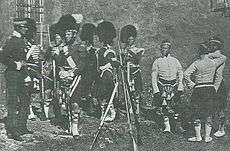
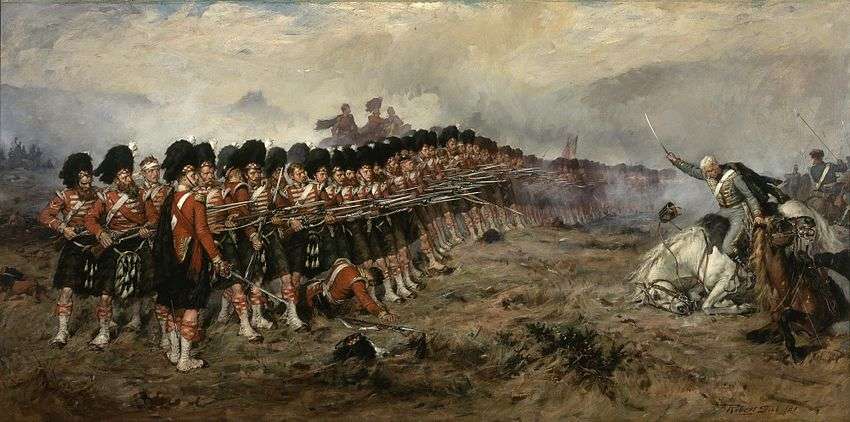
The 93rd Sutherland Highlanders became famous for its actions during the Crimean War. The regiment was sent to the Crimea in 1854, after war broke out against Russia, as part of Colin Campbell's Highland Brigade. It took part in the storming of the height above the Alma River followed by a move to Sevastopol. On 25 October, it was stationed outside the British-controlled port of Balaklava as part of its very thin defences. The Russian Army sent a massive force to attack Balaklava, the Russian force had an advantage of 25,000 soldiers; but only their massed cavalry pushed right forward down the road to Balaklava. Part of this threat was parried by the immortal charge of General Scarlett's Heavy Cavalry Brigade.[2]
| “ | The rest, a formidable mass, swept on to charge the 93rd drawn up in line, two deep. "There is no retreat from here, men," Campbell told them as he rode down the line, "you must die where you stand." And the reply of John Scott, the right-hand man, was taken up by them all: "Ay, Sir Colin. An needs be, we'll do that." They fired two volleys and the cavalry charge split in half, galloping to right and left and finally into full retreat. Some of the younger soldiers started excitedly forward for a bayonet charge, but Sir Colin called out, "93rd, 93rd, damn all that eagerness!".[3] | ” |
It was in this action that the regiment earned its nickname of The Thin Red Line, coined by The Times journalist W.H.Russell.
| “ | The Times correspondent, W. H. Russell, who standing on the hills above could clearly see that nothing stood between the Russian cavalry and the defenceless British base but the "thin red streak tipped with a line of steel" of the 93rd. Condensed almost immediately into "The Thin Red Line", the phrase has survived to this day as the chosen symbol of everything for which The Argyll and Sutherland Highlanders believe themselves to stand.
Asked why he had been so unorthodox as to receive a cavalry charge in line instead of in a square. Sir Colin Campbell said; "I knew the 93rd, and I did not think it worth the trouble of forming a square."[4] |
” |
A more staid historical author, Thomas Carter, also gave due credit. In describing the engagement, he wrote "Advancing in great strength, supported by artillery, the Russian cavalry appeared on the scene. One portion of them assailed the front and right flank of the 93rd., but were instantly driven back by the vigorous and steady fire of that distinguished regiment, under Lieutenant-Colonel Ainslie."[5] Col. William Bernard Ainslie was made a Companion of Bath (C.B.) for his leadership during the campaign.
Early 1856 & 1857 timeline
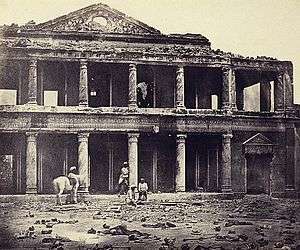
- Indian Rebellion of 1857 / Indian Mutiny
- 16 June 1856: Left the Crimea.
- 15 July: Arrive Portsmouth, proceed to Aldershot. Various British garrisons.
- 6 March 1857: Orders for China.
- 1 June 1857: Nos. 3, 7 & 8 companies embark at Plymouth for China.
- 16 June 1857: Rest of Regiment under Lt. Col. Leith Hay embark at Clarence Dockyard at Gosport.
- At Cape of Good Hope receive the news of mutiny of Bengal native army in India.
- 20 September 1857: Arrive at Calcutta. Welcomed by Sir Colin Campbell.
- 31 October 1857: Reach Cawnpore. They see remains of slaughter done by mutineers on women & children. Cross the Ganges River. Arrive Oude, join column assembling for Lucknow.
- 1 November 1857: One company engaged in battle at Futtehpoor with large force of rebels.
- 2 November 1857: Grenadier and nos. 1, 3 & 4 companies engaged in attack on fortified village in Oude, Buntara. Drive enemy out.
- 11 November 1857: Brigaded with HQ of the 53rd, & the 84th, 90th, 1st Madras Fusiliers & 4th Punjab Rifles, brigade commanded by Lt. Col. Adrian hope of the 93rd.
- 14 November 1857: 2nd relief of Lucknow begins.
- 16 November 1857: Storming and taking of Secunder Bagh (a walled garden fortification). By heavy cannonade a breach is made and the 93rd rushes in under heavy fire, at the same time storming the main gate, with the 4th Punjab Infantry Regiment.[6] Fierce hand-to-hand fighting for hours within the enclosure. By 3 pm, 2,000 Sepoy mutineers lie dead inside. Among the first to enter was Lt. Col. Ewart. Six Victoria Crosses awarded to the 93rd for their actions on this day. Sir Colin then calls upon the 93rd to take the Shah Nujeef fortification.
- 17 November 1857: At daybreak the Regimental colour is uncased atop a tower as a signal to the beleaguered garrison in the Residency.
- 18–22 November 1857: Evacuation of Residency garrison, women, children, 1000 wounded, the King of Oude, and 250,000 pounds of government money. 93rd covers the retreat.
- 29 November – 6 December 1857: Battle for Cawnpore. Rebels routed. Next days spent clearing district around Lucknow.
- 1 February 1858: Advance again on Lucknow.
- 1 March 1858: Battle for Lucknow begins.
- 9 March 1858: 93rd and brigade storm the Martiniere. Bivouac in Secunder Baugh.
- 11 March 1858: Storm Kaiser Baugh. 5,000 Sepoy rebels vs. 800 of the 93rd. Fierce hand-to-hand combat for 4 hours. 93rd: 15 killed, 47 wounded. Mutineers: over 860 dead. Victoria Cross awarded to Lt. Wm McBean for killing 11 enemy in succession with his sword at the gate.
- 21 March 1858: After severe skirmishing and street fighting, Lucknow cleared & in possession of the British. 93rd proceeds to camp at Dilkoosha.
- 7 April 1858: Join 42nd, 79th, artillery, 9th Lancers, & some native units all under Brig-Gen. Walpole. "Old Highland Brigade" under command of Brig. the Hon. Adrian Hope, of the 93rd. Proceed toward Rohilcund.
- 16 April 1858: Encounter rebel mud fort, which opens fire. Highlanders & Punjab Rifles push forward, return fire. Adrian Hope killed. Force withdraws at sunset. Enemy escapes during night. Col. Hay, CB of the 93rd, takes command of Highland Brigade.
- 20 April 1858: Battle at village of Allahgunge. Enemy dispersed. Bt. Lt. Col. Ross takes command of 93rd.
- 30 April 1858: Arrive Bareilly. Army reinforced.
- 5 May 1858: Battle on plains east of Bareilly. Enemy retires.
- 7 May 1858: City of Bareilly taken.
- 17 October 1858: To Shajehanpore. Form brigade with 60th Royal Rifles & 66th Gurkhas.
- 19 October 1858: Army encounters rebels entrenched at village of Poosgawah & expel them. The column breaks up to pursue. Rebel cavalry appears in the rear, attacking baggage column & cutting up campfollowers. 12 sick of the 93rd turn out of their dhoolies & open fire, holding the rebels in check until arrival of Mooltanee cavalry which disperses enemy.
- 26 October 1858: Battle at Russellpore. Enemy driven from position & put to flight.
- 8 November 1858: Royal proclamation read, transferring the government of India from the East India Company to the Queen.
- Through February 1859: Constantly employed under Gen. Troup hunting out rebels.
- Through 1870, various garrisons and postings in India.
- 14 February 1870: To Bombay. Leave India after 12½ years.
- 28 March 1870: Disembark at Leith, Scotland. Welcomed home with unbounded enthusiasm after 19 years away.
- 15 June 1871: To Edinburgh. One company left at Ballater as Guard of Honour to the Queen. Another at Aberdeen, at Ft. George, and at Greenlaw.
- 4 August 1871: Presented new colours by the Duchess of Sutherland.
- April 1872: At direction of the Queen, NCO'S & men issued "soft" tartan kilts & plaids, as the old "hard" tartan cut their knees.
- 11 May 1873: City of Edinburgh gives public farewell festivities for the 93rd.
- 12 May 1873: March through crowds of admirers & pass 91st Argyllshire Highlanders on their way to replace the 93rd.
- Through 1877 various British garrisons.
- 1877: Curragh camp near Dublin, Ireland.
- 1879: Part of garrison at Gibraltor.
Amalgamation
July 1881, the 93rd Sutherland Highlanders was united with the 91st (Argyllshire Highlanders) Regiment of Foot to form the 1st and 2nd Battalions of the Princess Louise's (Sutherland and Argyll Highlanders), later renamed Argyll and Sutherland Highlanders (Princess Louise's) . The traditions and character of the 93rd remained so strong that members of the 2nd Battalion would continue to refer to themselves as the 93rd right up until that battalions move in to suspended animation in 1947. For ten years a clumsy arrangement of the 1st and 2nd Battalions receding and taking front place with each other continued until the Colonel charged the 1st Battalion (old 91st) with absorbing and embodying the traditions of the 93rd.
Regimental Religious Traditions
Like most British regiments, the 93rd Highlanders developed its own traditions and character, some of which survived amalgamations. The 93rd Highlanders were reputed to be the most religious regiment in the British Army, outdoing even the Cameronians, who were originally formed from religious zealots. The regiment formed its own parish, with ministers and elders chosen from the ranks by the ranks. Two sergeants, two corporals, and two privates would be elected to serve as elders. The regiment was also said to be the only regiment with its own regular communion plate.[7]
The 93rd Sutherland Highlander Regiment is known for being the “Thin Red Line” of the British Army at the Battle of Balaclava in 1854. But the most important characteristic that set them apart as a regiment was a religious spirit. There was a large majority both of officers and men came from native Gaelic speaker’s area of Sutherland, assembled in the traditions of the family, clan and parish, In terms of tradition, no more than six families’ worship was not regularly kept both morning and evening. In addition, “The early training of the Highlander was round home fireside, he was taught to revere parents and ancestors, to be faithful to trust, to despise danger, to be respectful to superiors, to fear God and honour the King.” At that period, not many soldiers had well educated to recognize literatures, but the 93rd was amazing in that nearly every man could read and write. Nearly each soldier had his own Bible - often having been given to him by his family, and were therefore untied by a common bond of love for the highland homes they had left, and such a link between all ranks was bound to produce a magnificent spirit in a Regiment. It made the Regiment a spiritual family more than a bravery regiment. The Regiment had its own missionary fund, a regimental library, and a fund to support for widows and orphans of deceased soldiers. Whatever a man left the Regiment from sickness, wound or hurt it was the custom to subscribe a day’s pay a man as a presentation on quitting them. Also about 500 men regularly received the Sacrament from 750 men.[8] Away from home and their local church service so often, the 93rd men launched its own officially recognized congregation of the Church of Scotland at Foreign Service. The first Free Church Communion Service ever held in South Africa was with the forefather of this church, of the 90 foundation members, all about 27 were soldiers with the 93rd Regiment of Sutherland Highlanders. In 1813, the first free English Speaking Church was established at the Cape of Good Hope in South Africa. It normally considers the Cape Town Congregational Church began as a soldiers’ church. The example showed a remarkable sign of moral and religious influence and Christian charity of the 93rd regimental religious respect. There were also other Scottish regiments had Christian respect, but the 93rd is the unique one known to had its own Church and Communion Plate.[9]
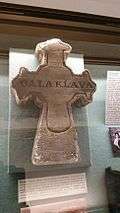
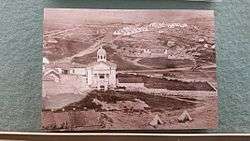
Meanwhile, the Regiment started meetings for studying the Scriptures and for prayers, to enjoy the advantages of spiritual instruction agreeably to the tenets of their national Church. At this time, the Regiment only had useof the services of a member of the Church of England, therefore the Regiment decided to engage a clergyman of the Church of Scotland to officiate as chaplain. In 1813, the men of the “93rd”, saw fit to purchase their own communion silver, and to hire their own Chaplain, the Rev. G. Thom, a Scottish missionary working in South Africa---the English speakers among them, and appointed as Elders 2 Sergeants, 2 Corporals and 2 Privates; also came together to assist their civilian brethren in establishing an English speaking church in Cape Town.. They also edited two large Regimental Bibles---one in English and the other in Gaelic. Comparing with the Regimental poor salary’s payment, it costed considerable sums of money—as much as five hundred pounds at one time- these were sacrificial acts of love for Christ, In a soldier’s diary, it shows a touched religious impression as below:“They were standing on the stairs leading to the gallery, sitting on the window sills, standing in the aisles, sitting on the pulpit stairs, and, indeed, listening outside the windows, and even then there was not room enough, as the front door was literally besieged by people anxious to obtain an entrance. But they had to be turned away. And that crowd for at least an hour and a half silently sat and stood entranced while the eminent Bishop declaimed on the eternal punishment of the impenitent soul; and no one could handle that subject better than him. The silence had been so intense on the part of listeners that at the end of the discourse there was a great sigh of relief;and the subject formed food for discussion for some days. Of course, the critics took it up, and the newspapers challenged the Bishop on certain points, but he would not be drawn into their net. He knew their purpose was only to increase the circulation of their papers by sensational discussion. On account of the numbers who could not obtain admission, and also for the benefit of the Mission, he had the sermon published in pamphlet form and sold for one anna each (equal to a penny). Naturally this experience made a great impression on my mind, and was the means of creating solemn thoughts on religious questions, which ultimately led to a decide stand for the better.”[10]
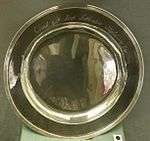

It was the 93rd regiment's men themselves who took its church life as seriously as they did when stationed at some place of foreign service. The men of Regiment were so much under the influence of moral and religious feeling that crime was almost unknown amongst them, and, as a compliment to their good behavior, the presence of the Regiment at parade for the infliction of corporal punishment upon any soldier of the garrison was always dispensed with, while all other corps were obliged to attend. From the Sutherland’s creation in 1799 to 1839, they had not seen any corporal punishment for thirty-two of those years, and in most of them, “not a single man was punished for anything”. In an era when flogging was common, if not routine, in most other regiments, this fact stood out. The authorities were well aware of the Sutherland men’s morality; at one point high ranking officers considered splitting up the 93rd so that their influence could be distributed to more unruly regiments. Thankfully for the men, they were allowed to stay together, regiment and kirk in one.
However, there were some challenges on the Regimental religious life. In 1843, the 93rd was in Canada. During its time there, the commanding officer Lt. Colonel Spark “actively threatened” soldiers, and refused to promote a soldier, William McBean, who had earned the honour. Spark was not picking up a rebellious spirit from the rebels he had come to quell, nor was he power-hungry. 1843 was a year of “major upset in Highland battalion religious life…the formation of the Free Church of Scotland”. This may seem like a minor issue. It was not for the 93rd. Lt. Colonel Spark was refusing to promote McBean on the grounds that he was a “Free Kirker”; the other men he threatened were attending Free Church services, and Spark was trying to put a stop to it. This religious split made a lasting division in the brigade, half going to the old denomination’s services, half to the new. Strangely, the authorities allowed this religious split, McBean was promoted, and both Old Kirkers and Free Kirkers were able to tolerate each other’s convictions, at least outwardly. In addition, the 93rd’s Brigadier Sir Colin Campbell, knowing their religious fervour, love for each other, and desire to be blameless before God and men, threatened them before a critical battle with these words: “Now men, you are going into action…No soldier must go carrying off wounded men. If any soldier does such a thing, his name shall be stuck up in his parish church.” With this unusual disgrace looming in front of them, all men obeyed. [11]
Fortunately, the negative religious pressure did not go on a long time, with the tradition of the Kirk of the 93rd continuing, the Battalion took over the Garrison Church here in Edinburgh, which is situated just at the rear of Redford Barracks, as its Regimental Kirk. The life of Kirk has proved as lively as ever with the founding of a Sunday school which has grown in strength under the leadership of Lady Fiona Campbell, the wife of Major Campbell, B Coy. A Children’s Choir was formed to lead the praise at the Sunday Service and was thought by all to be a great success. Some regimental families had children baptized on Sunday Service. The kirk also welcomed local Scouts and Bownies’ and the “Argyll” children from Royal Caledonian Schools, to a family service. The offerings from the Sunday Service was donated to a number of worthy charities including Erskme Hospital and Quarriers Homes. [12]
The men of Regiment were so much under the influence of moral and religious feeling, they encouraged fellow soldiers to respect authority, to live uprightly, and to fight knowing that God would direct the battle. Men of the 93rd fought for God, their families and the Empire. In a phrase, they displayed a Protestant war ethic. They remain a pattern for men today – men serving not only as soldiers, but for any man eager to utilize his time, money, and actions to speak for Christ in an embattled world.[13]
Battle honours
Battle hours won by the regiment were: [14]
- Cape of Good Hope 1806
- Crimean War: Alma, Balaklava, Sevastopol
- Indian Mutiny: Lucknow
Victoria Crosses
- Lance Corporal John Dunlay, Indian Mutiny (16 November 1857)
- Private Peter Grant, Indian Mutiny (16 November 1857)
- Private David MacKay, Indian Mutiny (16 November 1857)
- Lieutenant William McBean, Indian Mutiny (11 March 1858)
- Colour Sergeant James Munro, Indian Mutiny (16 November 1857)
- Sergeant John Paton, Indian Mutiny (16 November 1857)
- Captain William George Drummond Stewart, Indian Mutiny (16 November 1857)
Colonels of the Regiment
Colonels of the Regiment were: [14]
- 93rd (Highland) Regiment of Foot
- 1800–1822: Gen. William Wemyss of Wemyss
- 1822: Gen. Sir Thomas Hislop, Bt, GCB
- 1822–1832: Lt-Gen. Sir Hudson Lowe, KCB, GCMG
- 1832–1833: Lt-Gen. Sir John Cameron, KCB
- 1833–1840: Lt-Gen. Sir Jasper Nicolls, KCB
- 1840–1850: Gen. Sir James Dawes Douglas, GCB
- 1850–1852: Lt-Gen. William Wemyss (son of General William Wemyss, above)
- 1852–1858: Lt-Gen. Edward Parkinson, CB
- 1858–1860: F.M. Sir Colin Campbell, 1st Baron Clyde, GCB, KCSI
- 1860–1862: Lt-Gen. William Sutherland
- 93rd (Sutherland Highlanders) Regiment of Foot - (1861)
- 1862–1868: Gen. Alexander Fisher Macintosh, KH
- 1868–1873: Lt-Gen. Charles Craufurd Hay
- 1873–1875: Lt-Gen. Sir Henry William Stisted, KCB
- 1875–1876: Gen. Freeman Murray
- 1876–1880: Gen. William Munro, CB
- 1880: Gen. Mark Kerr Atherley
- 1880–1881: Gen. Hon. Sir Robert Rollo, KCB
See also
References
- ↑ William McElwee, Argyll and Sutherland Highlanders, (New York: Osprey Publishing, Ltd., 2002)p. 6.
- ↑ Greenwood, ch. 8
- ↑ Archived 4 September 2011 at the Wayback Machine.
- ↑ From the Argylls History Archived 4 September 2011 at the Wayback Machine.
- ↑ Thomas Carter, Medals of the British Army and How They were Won: The Crimean Campaign, Groombridge & Sons, London (1861).
- ↑ Regimental History of the 4th Battalion 13th Frontier Force Rifles (Wilde's), anonymous author, Central Library of RMA Sandhurst, pp.20–23
- ↑ Byron Farwell, Mr. Kipling's Army: All The Queen's Men (New York: W.W. Norton, 1981) p. 33.
- ↑ "RVD, 93rd Foot Regiment". Retrieved 2016-08-08.
- ↑ Cavendish, A.E.J (1928). An Reisimeid Chataich the 93rd Sutherland Highlanders, 1799-1927. UK: Published Privately.
- ↑ Ayre, A (1918). A Soldier's Diary and Poems: Reminiscent Prose and Rhyme, Penned in Spare and Working Time. UK: Standard Press.
- ↑ The Thin Red Line Regimental Magazine. UK. 1958.
- ↑ The Thin Red Line Regimental Magazine. UK. 1982.
- ↑ The Thin Red Line Regimental Magazine. UK. 1994.
- 1 2 "93rd (Sutherland Highlanders) Regiment of Foot". regiments.org. Archived from the original on 24 May 2006. Retrieved 12 August 2016.
- "Historical Records of the 93rd Sutherland Highlanders". compiled and edited by Roderick Hamilton Burgoyne, late 93rd Highlanders. London. 1883.
- "An Reisimeid Chataich, The 93rd Sutherland Highlanders", by Brig. Gen. A.E.J. Cavendish, CMG. 1928. Published Privately.
- "History of the 93rd Sutherland Highlanders...1800–1895", by Lt. Col. Percy Groves, R.G.A. W & AK Johnston, Edinburgh & London, 1895.
- "Records of Service and Campaigning In Many Lands", by Surgeon-General Munro, MD, CB., late of 93rd Highlanders. London. 1887.
- "Reminiscences of Military Service with the 93rd Sutherland Highlanders", by Surgeon-General Munro, MD, CB., formerly surgeon of the regiment. London. 1883.
- "Reminiscences of the Great Mutiny 1857–59", by Wm. Forbes-Mitchell, late sergeant 93rd Highlanders. London. 1895.
- "Recollections of A Highland Subaltern", by Lt. Col. W. Gordon-Alexander, late 93rd Highlanders. London. 1898.
- "Fighting Highlanders! The History of The Argyll & Sutherland Highlanders", by Major P.J.R. Mileham. London. 1993.
- "Famous Regiments, The Argyll and Sutherland Highlanders", by Douglas Sutherland, M.C. London. 1969.
- "The Scottish Regiments 1633–1987", by Maj. P.J.R. Mileham. 1988.
- "The Scottish Soldier", by Stephen Wood. Manchester. 1987.
- "Soldiers of Scotland", by Lt. Col. John Baynes Bt, M.Sc. 1988.
- "The Highland Brigade in the Crimea", founded on letters written during the years 1854, 1855 & 1856, by Lt. Col. Anthony Sterling, "a staff officer who was there". "A History of the Regiments & Uniforms of the British Army", by Major R.M. Barnes. London. 1950.
- "Scottish Military Uniforms", by Robert Wilkinson-Latham. Hippocrene Books, 1975.
- "Argyll and Sutherland Highlanders", by Wm. McElwee and Michael Roffe. Osprey. 1972.
- "The Naval War of 1812" by Theodore Roosevelt. NY, 1889.
- "Blaze of Glory – the Fight for New Orleans 1814–1815" by Samuel Carter III, St. Martin's Press, NY.
- "The Pictorial Field Book of the War of 1812", by Benson Lossing, NY 1869, reprint 1976.
- "The British at the Gates-The New Orleans Campaign in The War of 1812" by Robin Reilly. Putnam, NY 1974.
- "Amateurs to Arms", by Col. JR Elting.1991.
- "With Musket, Cannon and Sword – Battle Tactics of Napoleon and His Enemies" by Brent Nosworthy.
- "The Armies of Wellington" by Philip J. Haythornthwaite. 1994.
- "Weapons and Equipments of the Napoleonic Wars", by Philip J. Haythornthwaite. London, 1996.
- "British Infantry Of The Napoleonic Wars", by Philip J. Haythornthwaite. London, 1987.
- "Life In Wellington's Army", by Antony Brett-James. London, 1994 edition.
- "The Campaigns of the British Army at Washington and New Orleans, 1814–1815" by Rev. G. R. Gleig. London 1827.
- "A Subaltern in America, Comprising His Narrative of the British Army at Baltimore, Washington, etc..", by Rev. G. R. Gleig. Philadelphia, 1833.
- "British Sieges Of The Peninsular War", by Frederick Myatt. Spellmount, UK, 1987.
- "The Dawn of Modern Warfare – History of the Art of War, Vol. IV", by Hans Delbruck (1848–1929). Translated by Walter J. Renfroe, Jr. Univ. of Nebraska, 1990.
- "Biographical Sketches of the Veterans of the Battle of New Orleans 1814–1815" by Ronald R. Morazan. Legacy Publishing, 1979.
- "Frederick The Great on the Art of War", edited & translated by Jay Luvaas. NY, 1966.
- "Military Marching – A Pictorial History", by James Cramer. Forward by Lt. Gen. Sir Napier Crookenden, KCB, DSO, OBE, DL. Spellmount, 1992.
- "The Face of Battle", by John Keegan. NY, 1976.
- "The Mask of Command", by John Keegan. 1987.
- "Firepower – Weapons Effectiveness On The Battlefield, 1630–1850", by Maj. Gen. B.P. Hughes, CB, CBE. NY, 1997.
- "The FootSoldier", by Martin Windrow & Richard Hook. Oxford Univ. Press, 1982.
- "Forward into Battle-Fighting Tactics from Waterloo to the Near Future" by Paddy Griffith (16 years senior lecturer in War Studies at Sandhurst). Presidio Press, Novato, CA. 1990.
- "The Elements of the Science of War; Theory and Practice" by William Muller KGL 1811. (classic example of Pakenham's tactics being "by the book".)
- "The War of 1812 – A Forgotten Conflict" by Donald R. Hickey. Univ. of Illinois Press. 1989.
- "New Orleans 1815 – Andrew Jackson Crushes the British" by Timothy Pickles. Osprey, 1993.
- "The American War 1812–1814", by Philip Katcher, Osprey, 1990.
- "Twenty-Five Years in the Rifle Brigade" by W. Surtees, 1833. Reprint by Greenhill Books.
- "A Full and Correct Account of The Military Occurrences of the Late War Between Great Britain and the United States of America", by Wm. James, 1818.
- "The Battle of New Orleans – A British View", the Journal of Major C.R. Forrest, Asst. Quarter Master General, New Orleans Campaign. Intro and annotations by Hugh F. Rankin. The Hauser Press, New Orleans, 1961.
- "Rough Notes of Seven Campaigns in Portugal, Spain, France and America, 1809–1815", by John Spencer Cooper, late Sergeant, 7th Royal Fusiliers. Reprint of 1869 publication by Spellmount, 1996.
- "The Siege of New Orleans", by Charles B. Brooks, Univ. of Washington Press, 1961.
- "Various Anecdotes and Events of my Life --The Autobiography of Lt. Gen. Sir Harry Smith, covering the period 1787 to 1860", by Sir Harry Smith. First published in 2 volumes, edited by G.C. Moore, London, 1901.
- "The Historical Memoir of The War in West Florida and Louisiana in 1814–15, with an Atlas", by Arsene LaCarriere Latour, Major, principal engineer 7th Military District US Army, originally published 1816. The Historic New Orleans Collection and University of Florida Press. reprint 1999 – expanded edition edited by Gene A. Smith.
- "The Amphibious Campaign for West Florida and Louisiana, 1814–1815", by Wilburt S. Brown (Maj. Gen. USMC, retired), University of Alabama, 1969.
- "The Dawn's Early Light", by Walter Lord, NY 1972.
- "The War of 1812 – Land Operations", by George F.G. Stanley. MacMillan & national Museum of Canada, 1983.
- "When They Burned The White House", by Andrew Tully. NY, 1961.
- "The Baratarians and the Battle of New Orleans", by Jane Lucas de Grummond. Baton Rouge, 1961.
Further reading
- Greenwood, Adrian (2015). Victoria's Scottish Lion: The Life of Colin Campbell, Lord Clyde. UK: History Press. p. 496. ISBN 0-75095-685-2.
External links
- Regiments page at Clan Sutherland North America
- The Argylls History
- The British Regiments Site
- 93rd Sutherland Highland Regiment of Foot Living History Unit